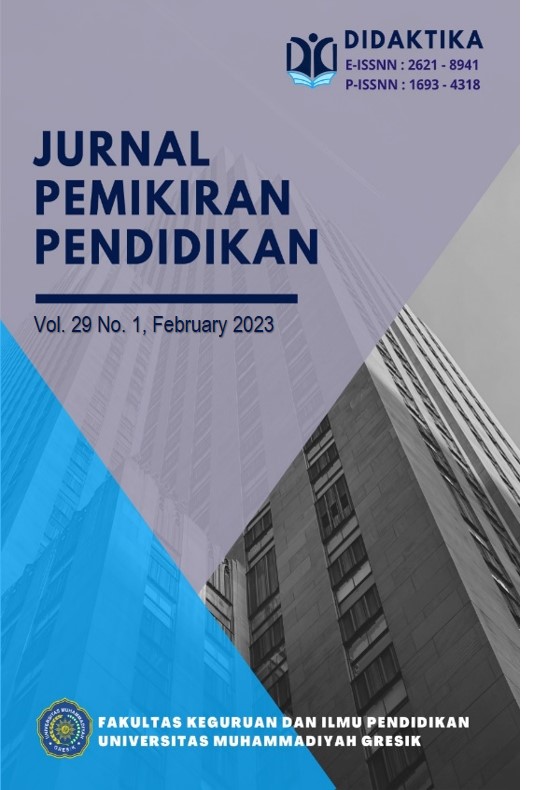The Effect Using Wordwall Game Applications To Improve Student’s Vocabulary In Chumchon Ban Phanokkhao School
DOI:
https://doi.org/10.30587/didaktika.v29i1.5246Keywords:
Wordwall; Game; Vocabulary;Abstract
This study aims to determine the effectiveness of the wordwall application used by students to increase English vocabulary. This type of research uses quantitative methods with research subjects of class VII, VIII and IX involving 30 students. The data collection method was carried out through pre-test, treatment, and post-test. Analysis of the data presented in this study by comparing the values of the pre-test and post-test (paired sample t test). The results of this study are; (1) there is a significant difference means from pretest and posttest for each class VII (pre = 75.00, post = 92,27), VIII (pre = 78,57, post = 92,14), IX (pre = 76,92, post = 90,00); (2) there is a difference in the average pretest and posttest learning outcomes with a sig value of 0.000 is less than 0.05 (0.000 < 0.05). It concludes that the wordwall application is effective in increasing English vocabulary. In addition, wordwall applications can increase mastery of vocabulary because of the simple steps. So, it might enhance enthusiasm in learning English vocabulary.
References
Arikunto, S. (2006). Prosedur penelitian suatu pendekatan praktek Edisi V. Jakarta: Rineka Cipta, 69.
Bakhsh, S. A. (2016). Using Games as a Tool in Teaching Vocabulary to Young Learners. English Language Teaching, 9(7), 120. https://doi.org/10.5539/elt.v9n7p120
Beno, H. (2019). The Effectiveness of Using Short Story to Improve Students’ Vocabulary Mastery. Langua: Journal of Linguistics, Literature, and Language Education, 2(2), 32–40. Retrieved from www.jurnal.stkipkieraha.ac.id/langua
Çil, E. (2021). The effect of using wordwall.net in increasing vocabulary knowledge of 5th grade EFL students. Language Education & Technology (LET Journal), 1(1), 21–28. Retrieved from http://langedutech.com
Darmawan, D. (2014). Inovasi pendidikan: pendekatan praktik teknologi multimedia dan pembelajaran online. PT Remaja Rosdakarya.
Fakhruddin, A. A., Firdaus, M., & Mauludiyah, L. (2021). Wordwall Application as a Media to Improve Arabic Vocabulary Mastery of Junior High School Students. Arabiyatuna : Jurnal Bahasa Arab, 5(2), 217. https://doi.org/10.29240/jba.v5i2.2773
Nenohai, J. A., Rokhim, D. A., Agustina, N. I., & Munzil, M. (2022). Development of Gamification-Based Wordwall Game Platform on Reaction Rate Materials. Orbital, 14(2), 116–122. https://doi.org/10.17807/orbital.v14i2.16206
Pradani, T. G. (2022). Tatsa+Galuh+Pradani. 1(5), 452–457.
Pradini, P. C., & Adnyayanti, N. L. P. E. (2022). Teaching English Vocabulary to Young Learners with Wordwall Application: An Experimental Study. Journal of Educational Study, 2(2), 187–196. https://doi.org/10.36663/joes.v2i2.351
Riani Ester Aruperes, Nihta V.F. Liando, R. R. (n.d.). The use of word wall game media to improve students’ vocabulary mastery at 7. Retrieved from https://www.semanticscholar.org/paper/THE-USE-OF-WORD-WALL-GAME-MEDIA-TO-IMPROVE-MASTERY-Aruperes-Liando/f9d8e14c517b49db07e9c4ca489d52b703500bb4
Richards, J. C., Richards, J. C., & Renandya, W. A. (2002). Methodology in Language Teaching: An Anthology of Current Practice. Cambridge University Press. Retrieved from https://books.google.co.id/books?id=VxnGXusQlI8C
Savitri, A. (2021). Pemanfaatan Game Edukasi Wordwall Sebagai Evaluasi Pembelajaran Bahasa Indonesia Secara Daring Di Perguruan Tinggi. ISoLEC 2021 Proceedings: Digital Transformation in Language, Education, and Culture: Challenges and Opportunities, (2014), 159–166.
Siti Faizatun Nissa, N. R. (2022). Penggunaan media pembelajaran wordwall untuk meningkatkan minat dan motivasi belajar siswa pada pembelajaran IPA di Sekolah Dasar. Educenter : Jurnal Ilmiah Pendidikan, 1(5), 452–457. https://doi.org/10.55904/educenter.v1i5.162
Downloads
Published
How to Cite
Issue
Section
License
License and Copyright Agreement
In submitting the manuscript to the journal, the authors certify that:
- They are authorized by their co-authors to enter into these arrangements.
- The work described has not been formally published before, except in the form of an abstract or as part of a published lecture, review, thesis, or overlay journal.
- That it is not under consideration for publication elsewhere,
- That its publication has been approved by all the author(s) and by the responsible authorities – tacitly or explicitly – of the institutes where the work has been carried out.
- They secure the right to reproduce any material that has already been published or copyrighted elsewhere.
- They agree to the following license and copyright agreement.
Copyright
Authors who publish with DIDAKTIKA: Jurnal Pemikiran Pendidikan agree to the following terms:
- Authors retain copyright and grant the journal right of first publication with the work simultaneously licensed under a Creative Commons Attribution License (CC BY-SA 4.0) that allows others to share the work with an acknowledgment of the work's authorship and initial publication in this journal.
- Authors are able to enter into separate, additional contractual arrangements for the non-exclusive distribution of the journal's published version of the work (e.g., post it to an institutional repository or publish it in a book), with an acknowledgment of its initial publication in this journal.
- Authors are permitted and encouraged to post their work online (e.g., in institutional repositories or on their website) prior to and during the submission process, as it can lead to productive exchanges, as well as earlier and greater citation of published work.
Licensing for Data Publication
Open Data and Software Publishing and Sharing
The journal strives to maximize the replicability of the research published in it. Authors are thus required to share all data, code or protocols underlying the research reported in their articles. Exceptions are permitted but have to be justified in a written public statement accompanying the article.
Datasets and software should be deposited and permanently archived inappropriate, trusted, general, or domain-specific repositories (please consult http://service.re3data.org and/or software repositories such as GitHub, GitLab, Bioinformatics.org, or equivalent). The associated persistent identifiers (e.g. DOI, or others) of the dataset(s) must be included in the data or software resources section of the article. Reference(s) to datasets and software should also be included in the reference list of the article with DOIs (where available). Where no domain-specific data repository exists, authors should deposit their datasets in a general repository such as ZENODO, Dryad, Dataverse, or others.
Small data may also be published as data files or packages supplementary to a research article, however, the authors should prefer in all cases a deposition in data repositories.











